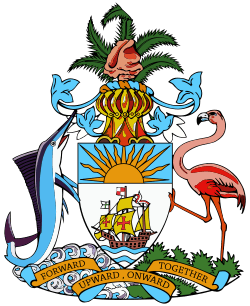1833 Bahamian general election
General elections were held in the Bahamas in December 1833. They were the first elections in which non-white residents were able to vote, and three non-white candidates were elected to the General Assembly; Stephen Dillet, Thomas Minns and John Deane.[1]
 |
|---|
| This article is part of a series on the politics and government of the Bahamas |
|
|
|
Local government |
|
|
|
|
Background
General elections had previously been held in 1832.[2] However, following a series of confrontations between the General Assembly and Governor Blayney Townley Balfour in 1833 over control of public buildings and the appointment of civil servants, Balfour dissolved the Assembly on 4 December 1833 after the Assembly voted by 21–2 to approve a resolution to withhold funding until the Governor accepted that the Assembly had control.[3] Balfour ordered that elections be held within a fortnight, with the vote in Nassau set for 17 December.[3]
Electoral system
The elections were the first to be held under the 1833 Act to Relieve His Majesty's Free Coloured and Black Subjects of the Bahamas Islands From All Civil Disability, which gave free non-white men over 21 the right to vote and stand in general elections in the territory, though slaves were still excluded.[4] Although property qualifications still severely restricted the franchise, with only around 4% of the population eligible to vote,[4] several non-white candidates ran in the elections.[3] The 25 members of the Assembly were elected in 13 constituencies ranging in size from one to four seats.[2]
Results
| Constituency | Date of election | Candidate | Votes | % | Notes |
|---|---|---|---|---|---|
| Andros | Robert Duncome | Elected | |||
| John Pinder | Elected | ||||
| Caicos | John McIntosh | Elected | |||
| Crooked Island | John Meadows | Elected | |||
| Eastern District | 21 December | George Anderson | Elected | ||
| Conrad Duncome | Elected | ||||
| Eleuthera | William Johnson | Elected | |||
| Robert Millar | Elected | ||||
| William Knowles | Elected | ||||
| Exuma | William Farrington | Elected | |||
| Henry Armbrister | Elected | ||||
| John Meadows | Elected | ||||
| Harbour Island | Henry Greenslade | Elected | |||
| William Vesey Munnings Jr | Elected | ||||
| Hugh Kerr | Elected | ||||
| Long Island | Henry Adderley | Elected | |||
| Nassau | 17 December | George Wood | 77 | 25.5 | Elected |
| Stephen Dillet | 67 | 22.2 | Elected | ||
| John Storr | 55 | 18.2 | Elected | ||
| Robert Butler | 55 | 18.2 | Elected | ||
| Thomas Saunders | 25 | 8.3 | |||
| Thomas Forster | 22 | 7.3 | |||
| Neil M'Queen | 1 | 0.3 | |||
| San Salvador | William Vesey Munnings Sr | Elected | |||
| Turks Island | Henshall Stubbs | Elected | |||
| Watlings Island & Rum Key | Charles Nesbitt | Elected | |||
| Western District | 21 December | Thomas Minns | 46 | 50.0 | Elected |
| John Deane | 46 | 50.0 | Elected | ||
| Source: Hart | |||||
Aftermath
Henry Adderley, the elected member for Long Island, claimed that he had been elected "contrary to his wish and consent", and asked to be excused from the Assembly.[2] The Assembly was opened on 17 January 1834.[5]
In July 1834, several by-elections were held to elect additional members; George Anderson and Thomas Cartwright were elected from Exuma, George Adderly and Benjamin Sims Jr were elected from Long Island, James Malcolm was elected from Harbour Island, and George Camplejohn and Samuel Clutsam were elected from Eleuthera.[2]
References
- Dwight C. Hart (2004) The Bahmian Parliament, 1729-2004: Commemorating the 275th anniversary, Jones Publications, p4
- Hart, p39
- Hart, pp60–61
- Hart, pp59–60
- Hart, p62